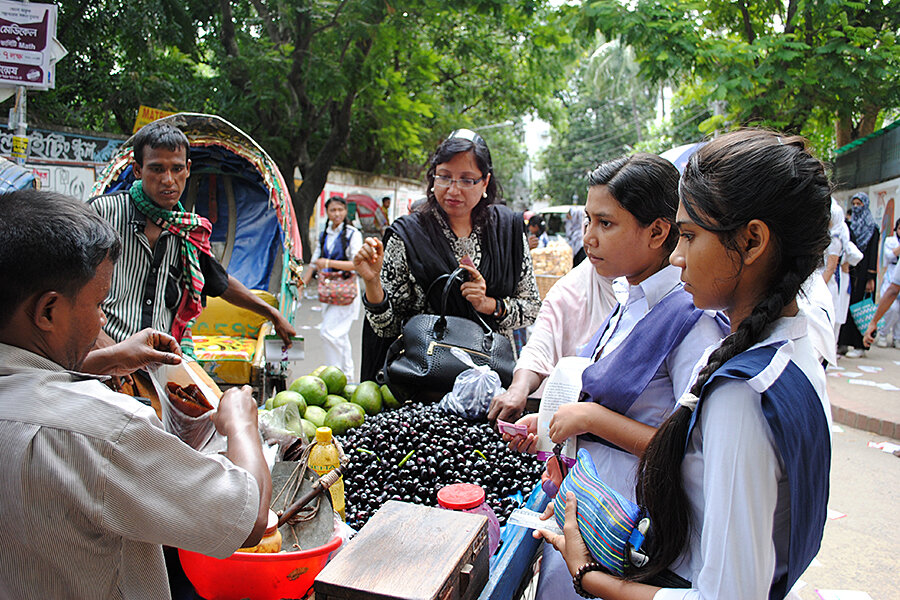Disaster training in Bangladesh: What to do when the earth starts shaking
Loading...
| Dhaka, Bangladesh
Students like Eidia Zaman grew up knowing about the threat of cyclones and floods to her coastal country. Now a pilot program supported by the Bangladesh government and the UN is helping her learn some practical responses should an earthquake hit the Dhanmondi Government Girls’ School, where she spends nearly half her time.
If the earth starts shaking, Ms. Zaman explains, she will cover her head with a book or backpack, and not panic and run during the evacuation. “We must remove nervousness,” she says.
On a hot spring day – not long after a massive earthquake rocked nearby Nepal – students at the school in white and blue uniforms pore over exams under the watchful eye of English teacher Umma Khan. She points to leafy trees outside and says one will be cut down since it could crash through a window and wreak havoc.
Ms. Khan, like 2,800 other teachers in Bangladesh, recently went through a three-day Comprehensive Disaster Management Program (CDMP). It offered a litany of basics for response to earthquakes like the one in Kathmandu: How to protect oneself from falling objects and furniture that could topple; why to stay away from glass objects; how to evacuate in orderly fashion; and not forgetting to turn off gas burners that can lead quickly to fires.
Around 4,600 teachers in Bangladesh are expected to take the training and then relay the knowledge to administrators, students, parents and fellow teachers.
A densely populated country
Bangladesh may be infamous for powerful cyclones and floods. But it's also earthquake prone. In 1897, a quake of 8.7 magnitude struck the northeast. Another major quake today would be devastating in one of the world’s most densely populated countries with 160 million people, many living in poorly constructed urban buildings.
Approximately 72,000 buildings would collapse if an earthquake of 7.5 magnitude struck Dhaka, according to a 2004 CDMP study. However, it says a few simple drills and simple measures learned by ordinary people could save many lives.
Earthquake preparedness for students and teachers is important given that school children spend half their waking hours in school. In earthquakes in Pakistan in 2005 and China’s Sichuan Province in 2008, some 19,000 and 10,000 children respectively were killed when thousands of schools collapsed.
The Nepal earthquake in April left more than 8,500 dead across the mountainous country. Had it happened during school hours, “the impact would have been several times more catastrophic,” said Dr. Unni Krishnan, head of Disaster Response and Preparedness at Plan International, an aid group.
Other Asian countries have also stepped up disaster preparedness in schools.
In Aceh, the Indonesian province and epicenter of the 2004 Indian Ocean tsunami, more than 2,400 teachers have been trained to conduct safety drills. After the tsunami, Aceh’s education department also developed curricula and teaching materials focused on dealing with natural disasters.
Avoiding panic
In the Philippines, UNICEF is expanding emergency drills in schools to prepare children for typhoons that regularly strike the country, and other disasters.
Bangladesh itself in 2004 incorporated lessons on climate change and disaster response into textbooks for grades three to 12 to reach 20 million students.
Still, there's a long way to go to make earthquake safety commonplace in the way cyclone awareness is here. A cyclone warning system started in 1972 today relies on 50,000 volunteers.
One question is over the sharing of knowledge by teachers at their schools. For unmotivated teachers, there is no mandated accountability. “If teachers don’t deliver the knowledge to students, what will happen?” asks Masud Khan, a disaster preparedness specialist at CDMP in Dhaka.
“People in our country are not concerned about earthquake drills. But now parents are more aware. Maybe they will do the drills now.”
Mahfooza Hossaine, headmistress of the Dhanmondi school, points to a lack of fire extinguishers and other safety equipment. The two-story building in an upscale part of Dhaka has wide staircases and multiple exits, but many poor public schools in Bangladesh do not. And while teachers receive books during their training, students and schools don’t get posters, pamphlets or other materials.
Eventually experts hope school safety can become second nature. “Drills will go a long way to save lives,” says Dr. Krishnan of Plan International. “The big idea should be to build a culture of safety and bolster resilience.”







